|
[Front Page] [Features] [Departments] [Society Home] [Subscribe]

First Cuttings
Australian Plants Societies
Australian Plants online is brought to you by the 7 Societies that make up the Association of Societies for Growing Australian Plants (ASGAP).
Have you ever thought of joining one of the Societies? There is a Regional Society in every Australian state and also in the Australian Capital Territory. In addition, there are over 100 district groups established in centres throughout Australia.
Membership brings many benefits - regular district group and Regional newsletters, the colour journal "Australian Plants", access to free seed banks, regular meetings with expert speakers, bush walks, garden visits, advice from experienced growers, access to difficult to obtain plants and access to Study Groups.
Why not take a look at the Membership Page and see what we have to offer?

Macadamia Nuts and Dogs - A Warning
In recent issues, the various ways of cracking Macadamia nuts was canvassed - and a lot of innovative methods there are too! But a few subscribers mentioned that their dogs were expert at cracking the nuts and this led to the following contribution from Elwyn Hegarty (University of Queensland) on the potential dangers to the animals....

"I watched with interest the suggestions for cracking macadamia nuts, but I'm anxious about encouraging dogs to eat them. Not only did we once have a rather small dog that we actually saw swallow a whole unshelled nut (despite a trip to the vet, who decided against operating, it died after a couple of days), but there is also some good evidence that the nuts can be poisonous to dogs. It may be like peanut allergy, affecting only some humans, but some veterinary authorities warn against giving macadamia nuts to dogs.
There is a recent paper in Veterinary and Human Toxicology (42(1) 18-21, Febuary 2000) that reviews a five-year record of 29 cases of ill-effects to dogs that had eaten commercial macadamias and a subsequent experimental feeding of four more dogs with 20 grams of nuts. None of the 33 dogs died, but they all had temporary symptoms such as weakness, depression, tremor, stiffness etc. The reports comes from the National Animal Poison Control Center in the USA. The full text of this paper and what kinds of dogs were involved can be found at the Veterinary and Human Toxicology website.

I have also found what is probably an even more relevant recent local report of a study by several Queensland-NSW authors - Macadamia Nut Poisoning of Dogs by RA McKenzie (and nine other veterinarians), in Australian Veterinary Practitioner Vol. 30 No 1. March 2000. A number of small and large dogs of both sexes, various ages and a number of breeds, which had eaten various quantities of macadamia kernels (either fed to them or obtained from chewing fallen nuts) were temporarily affected by such problems as paralysis of the hind limbs, depression, general weakness and local tenderness. "Multiple episodes" were reported for two of the dogs who must have been particularly fond of the nuts, and apparently able to help themselves in the season. Again, all the dogs recovered fully after 1-3 days, but they were all very uncomfortable for a while."

A Couple of New Correas
"A new cultivar, Correa 'Federation Belle' was launched at the "Oracles of the Bush" festival in Bruxner Park, Tenterfield on Saturday, April 21.
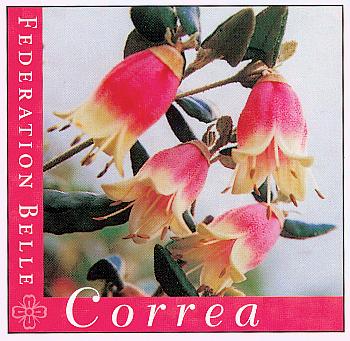 
The cultivar is a chance seedling which arose in the nursery garden of David and Sarah Caldwell of Mole River Station, Torrington, in northern New South Wales. It is a hybrid between Correa 'Marian's Marvel' and a form of Correa reflexa var. speciosa. The flower is larger than 'Marian's Marvel' and a brighter pink colour. The plant is smaller than 'Marian's Marvel' and reasonably bushy with pruning. Plants will be available commercially from Mole Station Nursery. The current stock is almost sold out but Sarah is propagating as much tubestock as she can to meet demand.
The cultivar is being promoted nationally through commercial gardening magazines.
Another new Correa is "Granny's Grave"!
To quote from the June 2001 issue of Growing Australian, the newsletter of the Australian Plants Society (Vic).....
"During 1824 a lady known as Granny Raddleston died in the Warrnambool area and, as there was no organised cemetery until 1853, a land owner, Mr John Allen agreed to bury Mrs Raddleston in the sand hills along the coast....
In 1903, the Warrnambool Council erected a Tomb Stone on the grave as she was the first white lady buried in Warrnambool.
The area where the tomb still stands is covered with coastal vegetation and this is where members off SGAP Warrnambool first came across a very attractive , low growing, green Correa reflexa. The new growth is particularly attractive gaining a reddish appearance..... SGAP Warrnambool applied to ACRA to have it registered. The name "Granny's Grave" did not meet, initially, with approval being considered "too morbid", but has now been accepted. It does have a certain appeal once one knows the history of the area."

This symposium celebrates the bicentenary of the arrival of the HMS Investigator in Australia at the start of Matthew Flinders' survey of the coast of Australia.
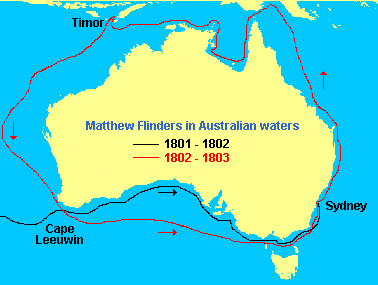 
The Symposium will take place from Sunday 9 to Tuesday 11 December 2001 at Albany, Western Australia. It will focus on the stays of the Investigator in south-western Australia from 9 December 1801 to 5 January 1802 at King George Sound, and from 9 to 14 January 1802 at Lucky Bay, east of where Esperance now stands. These were the first two Australian landfalls of the voyage.
Besides Flinders' charting work, the landfalls were outstanding for the botanical work of Robert Brown, Ferdinand Bauer and Peter Good, and the landscape art of William Westall.
The symposium will commemorate their visit through a series of invited papers over two days, preceded by a day of excursions to sites visited by members of the expedition.
The Symposium is being organised by the Australian Systematic Botany Society, The Wildflower Society of Western Australia and the Western Australian Herbarium. Further details are available at the Symposium web site.

Netwatch
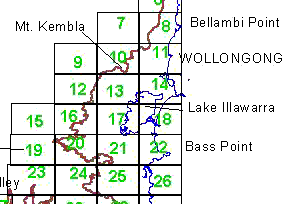 
This is a community initiative by the Nature Conservation Council of NSW developed with funding assistance from the NSW Government's Environmental Trust and the Illawarra Catchment Management Committee.
The database is a series of flora species lists for several hundred locations locations in the Illawarra region of New South Wales. The data come from a wide range of published and unpublished sources, principally lists of species compiled by Mark Robinson, Andes Bofeldt and Keven Mills.
The data is accessible either via a list of locations in the region or through a key map broken up into a grid of 44 smaller maps (see extract, left).
This is part of the Nature Conservation Council's Urban Bushland pages. It consists of a series of independent articles and information of the ecology of bushland in western Sydney.
Topics covered include:
- The Native Vegetation Of Western Sydney
- Birds And Mammals Of North-West Sydney
- Legal Measures To Protect Urban Bushland In Western Sydney
- The Management Of Urban Bushland In Western Sydney: The Basis For Action. A Local Government Perspective
- The Management And Restoration Of Native Grasslands
- Site Assessment -- A Vital Part Of Bush Regeneration
- How To Mount A Campaign
- Getting Started: Councils And Volunteers
- Priority Areas In Western Sydney
An excellent reference for anyone interested in urban bushland.
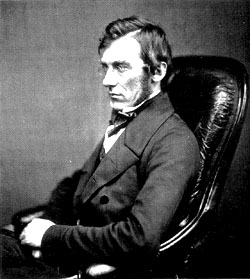
Joseph Dalton Hooker was arguably the most important British botanist of the nineteenth century. A traveller and plant-collector, he was a close of friend of Charles Darwin and eventually became director of the Britain's Royal Botanic Gardens, Kew, succeeding his father, William Jackson Hooker, in that position.
Joseph is commemorated in several Australian plants including Ozothamnus hookeri although not all plants with "hookeri" or "hookeriana" in their names are named after him - several are named in honour of his father (eg. Grevillea hookeriana) and Banksia hookeriana is named after both of them.
These pages are intended to provide some basic information about Joseph Hooker. They include biographical notes, information about Hooker's collectors and correspondents in Australia and New Zealand, links to web resources that contain information about Hooker, the history of botany and natural history and a guide to some of the archival sources concerning Hooker.
This is a test site for a proposed Natural History Database and is part of The Scholarly Electronic Text and Image Service. Currently, it contains two particularly interesting publications in their entirety.
- Forest Flora of New South Wales
  The first part of Forest Flora of New South Wales by J.H. Maiden appeared in 1902, consisting of 4 issues and priced at one shilling. The final part, Number 77, appeared in 1924 priced at two shillings and sixpence. In the 77 parts there are 304 issues each devoted to a single plant, but often containing extra material of more general interest to Maiden. The parts were eventually bound into 8 volumes, all of which are reproduced on the site.
The first part of Forest Flora of New South Wales by J.H. Maiden appeared in 1902, consisting of 4 issues and priced at one shilling. The final part, Number 77, appeared in 1924 priced at two shillings and sixpence. In the 77 parts there are 304 issues each devoted to a single plant, but often containing extra material of more general interest to Maiden. The parts were eventually bound into 8 volumes, all of which are reproduced on the site.
Although superseded by more recent publications, Forest Flora of New South Wales is more than mere historical interest.
The excellent illustrations are particularly valuable - extract of Brachychiton populneus (Kurrajong) illustration shown above.
- The Flower Chain: The Early Discovery of Australian Plants
In contrast to Forest Flora of Australia, The Flower Chain is of much more recent origin, being published in 1998. In this book Jill, Duchess of Hamilton, examines "the discovery, identification, appreciation and cultivation of Australia's plants, together with the sea captains, botanists, artists, gardeners, laymen, books and drawings, which all contributed to the slow introduction of the Australian flora to Europe and the rest of the world."
A review of The Flower Chain was published in the March 2001 issue of Australian Plants online.
For most of his professional life, Len Webb was associated with the Australian CSIRO, retiring as Senior Principal Research Scientist in the CSIRO Rainforest Ecology Unit in 1980. He then began a long association with Griffith University as an Honorary Professor in its Division of Environmental Studies. During his long career he has held many important national and international positions including Foundation Councillor of the Australian Conservation Foundation (1965); Vice-President, Queensland Wildlife Preservation Society (1963); Member of the UNESCO National Commission, Australia (1975-76); member of the Australian National Man and the Biosphere (MAB) Committee (1974-80); a contributor to an international study week on tropical forests at the Pontifical Academy of Sciences in the Vatican City (1990); and a member of the Commission on Ecology of the International Union for the Conservation of Nature (IUCN)(1979-90).
These images form part of a collection of around two thousand 35mm transparencies taken by Len Webb and a few others during the course of many years. They depict a wide variety of native vegetation, fauna and landscapes, mainly in tropical and subtropical Northeastern Australia, and are of considerable historical value, as many of the sites have now been lost or have suffered disturbance of various forms.
The scope of the images cover:
Although some of the images show deterioration because of their age, they are being made available because of their historical and ecological interest, rather than outright photographic quality.
Melbourne and other parts of Victoria are currently experiencing the worst long duration drought on record. So, it's not surprising that many people are looking at ways to minimize water use.
 
This site is part of Melbourne Water's larger Conserve Water site. It is a searchable database of plants (mainly native) to suit a water-wise garden. The database allows selection of plants ranging from trees to groundcovers and produces a "hit list" of suggestions from "25 of the best" and "50 of the next best" recommendations.
It's an excellent idea and is well implemented but it suffers from a database that is too small (only 75 species). In addition, the "more information" links that appear next to each species in the "hit list" don't actually provide any more information.
The site also includes:
- Lawn and Gardening watering tips
- Case Studies - A native garden in Eltham, a "dry" and mostly exotic garden outside Geelong and the Water Conservation Garden at the Royal Botanic Gardens Melbourner.
- FAQs including "What's the best time to water my garden?", "How long should I spend watering my garden?", "How much water does my automatic watering system use?", "How much water do I use when I clean my driveway?", "How much water does my lawn need?" and "How do I keep my lawn looking good in summer?"
While you're at the site, you might like to try out the Water Conservation Wizard. The amount of water you're using in comparison to a "water-wise" home will probably shock you!

A "cultivar" is the basic grouping for cultivated varieties of plants. By "cultivated plants" is meant plants raised in cultivation which differ sufficiently from their wild ancestors or, if taken into cultivation from the wild, are worthy enough of distinction from wild populations for horticultural purposes to merit special names.

Pimelea "Bonne Petite" (22k)

Correa "Ivory Bells" (23k)
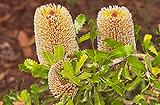
Banksia "Pigmy Possum" (50k)

Anigozanthos "Regal Claw" (39k)

Pandorea "Golden Showers" (34k)
|
|
The naming of cultivars is governed by the International Code of Nomenclature for Cultivated Plants (ICNCP). This is a separate system to that used for wild plants, the International Code of Botanical Nomenclature.
The Australian Cultivar Registration Authority (ACRA) is the International Registration Authority for Australian plant genera. The objectives and purposes of ACRA include:
- To register, in accordance with the International Code of Nomenclature for Cultivated Plants, names of cultivars of Australian native plants.
- To record the names of all cultivars of Australian native plants and hybrids between Australian and exotic plants.
- To encourage the horticultural development of the Australian flora.
- To assess and describe cultivars submitted for registration.
- To maintain a register, together with correspondence files, herbarium specimens, photographic collections and any other necessary information.
Plants that can be considered as cultivars include:
- Deliberate hybrids.
- Accidental hybrids in cultivation.
- Selection from existing cultivated stock.
- Selection from variants within a wild population and maintained as a recognisable entity solely by continued propagation.
Anyone can apply for registration of a plant name by submitting a fresh specimen (to check the description, to colour code, and finally to use as a herbarium specimen), a colour photograph (preferably a slide), some information about origins, cultivation experience, and distinguishing features, etc. This is covered by the application form (available on request). The fee for this is $50, unless the application is by a SGAP study group.
The ACRA's site also includes some guidelines for naming of cultivars in accordance with the International Code for Nomenclature of Cultivated Plants, 1995.
There are currently 670 cultivars registered with ACRA, some of which are shown at left (Select a thumbnail image or highlighted name for a higher resolution image.)
|

Australian Flora Foundation
Ian Cox, the ASGAP representative on the Foundation has advised of the following approved research grants for 2001.

| Project | Researchers |
| The importance of soil-stored seed bank as a reservoir of genetic diversity in the endangered plant Grevillea caleyi | Ms Tanya Lorens and Prof. R Whelan, University of Wollongong |
| Strategies for the conservation of Hakea pulvinifera using in vitro and ex situ breeding techniques | Assoc Prof Acram Taji, University of New England |
| Genetic diversity in the rare tropical tree Ryparosa javanica | Bruce Webber and Dr Ian Woodrow, University of Melbourne |
The proponents of a further project have been asked for additional information.
Donations over $2 to the Australian Flora Foundation are tax deductible. The Foundation is an "Approved Research Institute" as defined in the Income Tax Assessment Act.
Donations or requests for grant applications may be sent to:-
Australian Flora Foundation Inc.
PO Box 1566
University of Queensland
Gatton
Queensland, 4343
Australia
For further information on the Foundation, contact the President, Richard Williams (richard.williams@mailbox.uq.edu.au).

"Australian Plants"....in print!
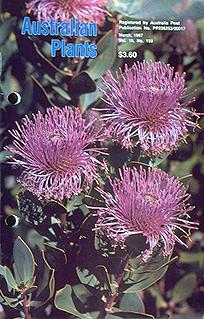 
The Society's 48 page, colour (printed) journal, "Australian Plants" has been published quarterly since 1959. It carries articles of interest to both amateur growers and professionals in botany and horticulture. Its authors include the leading professional and amateur researchers working in with the Australian flora and many beautiful and high quality photographs of Australian plants are published in its pages. Topics covered by the journal cover a wide range and include landscaping, growing, botany, propagation and conservation.
A subscription to the print version of "Australian Plants" is $19.80 annually for 4 issues (overseas $AUS32) including postage. To subscribe, print out the Subscription Form and post or fax the appropriate fee to the address indicated on the form.
Note that the contents of "Australian Plants" and "Australian Plants online"
are totally different.
These are some of the topics covered in recent issues of "Australian Plants":
Growing Hakea in a Dry Climate
Olearia - Plants of the daisy family
The Olympic and Paralympic Bouquets
Eucalyptus cabinet timbers
Eremophila as Cut Flowers
Eremophila Seed Germination
Cassia and Senna in Australia
Australian Ferns - Growing them successfully
Smoke induced germination
Tea trees
The "Honeypot" Dryandras
Bernawarra Gardens - Tasmania
Plants for wet areas
Philotheca and Eriostemon - name changes
Lilly Pilly cultivars
Tropical legumes
Eucalyptus cinerea - lignotuber studies
Nutritional needs of Proteaceae
Labichea and Petalostylis
Xyris in Australia
Ferns in a garden
Yellow Waratah...Telopea truncata form
"Pines" of Tasmania
Tasmanian plants in horticulture in Britain
Eucalypts of Tasmania
Cut flower production trials
Emu Bush - Growing Eremophila
Kangaroo Paws - for colour
Creating a native garden...For beginners
Native honeysuckle; The genus Lambertia
Fertilizing for grevilleas
Creating homes for birds and mammals
Mistletoe; their natural biological control
|
Hakea for Cultivation
Grafted Hakea
Ornamental Eucalypts for cut flower production
Leptospermum - colourful cultivars
Australian Rushes
Native Bees and Seed Dispersal
Sun Orchids - Thelymitra
Eucalyptus Foliage - Cut stems and postharvest
Vegetation of Macquarie Island
Grevillea - care and maintenance
Proteaceae of the rainforest
Richmond Birdwing butterfly
Terrestrial orchids of Royal National Park
Bladderworts - carnivorous plants
New Banksia releases
Edible wattle seeds - southern Australia
An introduction to legumes of Australia
Orchids as garden features
Native lowland grasslands of Tasmania
Orities - Tasmanian endemics
Gardening in clay
The daisy family
The tea tree oil industry
Riceflower - an everlasting daisy as a cut flower
Corkwood as a source of medicine
Outback Gardening - Achieving water efficiency
Pioneering Quandong as a fruit
Commercial cropping in the dry Interior
Bush food plantations
Rainforest plants - horticulture and bush tucker
Native fruits - Aboriginal food
About plant roots
NSW Christmas Bush: Cut flower industry
|

[Front Page] [Features] [Departments] [Society Home] [Subscribe]
Australian Plants online - June 2001
Association of Societies for Growing Australian Plants
|